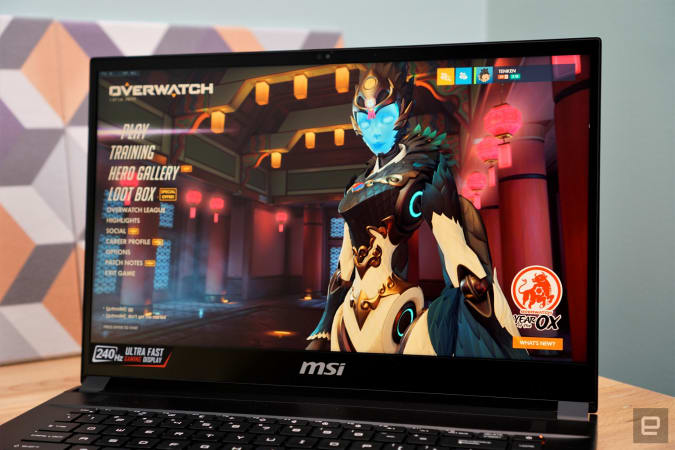[ad_1]
MSI’s latest GS66 Stealth may look the same as last year’s model, but it has a lot more going for it. It’s powered by NVIDIA’s new RTX 30-series GPUs, and it’s one of the first gaming notebooks with a 1440p (or 2K) screen. That’s a big deal. For the last few years, laptop gamers could choose from low-resolution, 1080p screens with fast refresh rates, or 4K displays that pack in a ton of pixels, but also require a ton of power to render games.
1440p is a nice middle ground: It’s sharper than 1080p, but isn’t as demanding as 4K. The MSI GS66 Stealth, and other notebooks sporting 1440p, also supports fast refresh rates to make gameplay look silky smooth. So take this new screen tech, more power and the relatively slim design of the GS66 altogether, and it seems like a winner, right?

Pros
- Understated and clean design
- Supports NVIDIA’s RTX 30-series GPUs
- Fast and smooth 240Hz 1440p screen option
Cons
- Incredibly loud fans
- Keyboard could offer better feedback
- Requires manual GPU tweaking at times
Gallery: MSI GS66 Stealth (2021) | 7 Photos
Gallery: MSI GS66 Stealth (2021) | 7 Photos
For the most part, yes. But I came across one major downside: tons of fan noise. That’s the cost of cramming so much hardware into a thin notebook. And while fan noise is something every PC gamer has to deal with, the GS66’s cooling system was far louder than most.
But let’s start with the good stuff first. As soon as I got the GS66, equipped with NVIDIA’s RTX 3080 mobile GPU, Intel’s i7-10870H CPU and 16GB of RAM, I promptly installed Overwatch to see just how well its 240Hz 1440p screen performed. I wasn’t disappointed. That 240Hz figure means the screen can display up to four times as many frames every second, compared to standard 60Hz monitors. The more data, the smoother everything looks. Pretty simple.
In Overwatch, I reached around 175FPS on average with epic graphics settings in 1440p. The fluidity of the gameplay made it easier for me to line up sniper shots or just wreak havoc as Junkrat. Sure, I’ve seen the game run even faster on last year’s GS66, which had a 300Hz 1080p display. But that lower resolution delivered less detail whenever I slowed down to take a close look at Overwatch’s characters and stages. With the new 1440p display, I could make out things like the fine lines in costumes, as well as distant objects and players that were a bit muddy in 1080p. I’d gladly trade off an insanely high refresh rate like 300Hz for a slightly better screen.

Devindra Hardawar/Engadget
And while 4K screens are obviously sharper, gaming in 1440p requires a lot less horsepower. You’ll likely see great results with the GS66 even if it doesn’t have NVIDIA’s most powerful graphics card. Most 4K screens have largely been limited to 60Hz refresh rates, so even if you could run a game well, it could never look as smooth as a 1080p screen. Ironic, isn’t it? We’re seeing 120Hz 4K screens now in pricey machines like the Razer Blade Pro 17, but that’s still pretty rare.
1440p isn’t a particularly useful resolution when it comes to watching videos, but the GS66’s screen still made streaming content look great. That 240Hz panel also made browsing the web and perusing documents incredibly smooth — though you have to enable NVIDIA’s GPU manually to see the full benefits of that refresh rate. By default, the GS66 uses NVIDIA’s Optimus technology to automatically switch between the system’s integrated Intel graphics and the RTX 3080 GPU. That helps with battery life, but it also limits the screen to a more standard 60Hz with integrated graphics. And as a side note: If you’re still not sold on 1440p as the ideal gaming resolution, you can also snag the GS66 with a 300Hz 1080p screen or a 4K panel.
|
PCMark 10 |
3DMark (TimeSpy Extreme) |
Geekbench 5 |
ATTO (top reads/writes) |
|
|
MSI GS66 Stealth (2021, Intel i7-10870H, NVIDIA RTX 3080 Max-Q) |
5369 |
4,538 |
1,247/6,505 |
3.1 GB/s / 2.9 GB/s |
|
MSI GS66 Stealth (2020, Intel Core i7-10750H, NVIDIA RTX 2070 Super Max-Q) |
4,778 |
3,231 |
1,159/6,901 |
1.8 GB/s / 1.8 GB/s |
|
Gigabyte Aero 17 HDR XB (Intel i7-10875H, NVIDIA RTX 2070 Super Max-Q) |
5,155 |
3,495 |
1,137/5,681 |
2.93 GB/s / 2.59 GB/s |
|
ASUS Zephyrus Duo 15 (Intel i9-10980HK, NVIDIA RTX 2080 Super Max-Q) |
5,616 |
3,680 |
1,365/8,055 |
3 GB/s / 3.24 GB/s |
|
ASUS Zephyrus G14 (AMD Ryzen 9 4900HS, NVIDIA RTX 2060 Max-Q) |
5,436 |
2,725 |
1,189/7,705 |
1.7 GB/s / 1.67 GB/s |
Moving on to a more demanding game, the GS66 was able to run Control between 55 and 75FPS with maxed out graphics and ray tracing settings. I had to use NVIDIA’s DLSS technology to achieve that smooth gameplay though, which means it was actually being rendered at a resolution lower than 1440p, before being scaled back up with AI algorithms. Given just how taxing ray tracing can be, I’ve found DLSS to practically be a requirement with Control, no matter which system I’m playing on.
[ad_2]
Source link